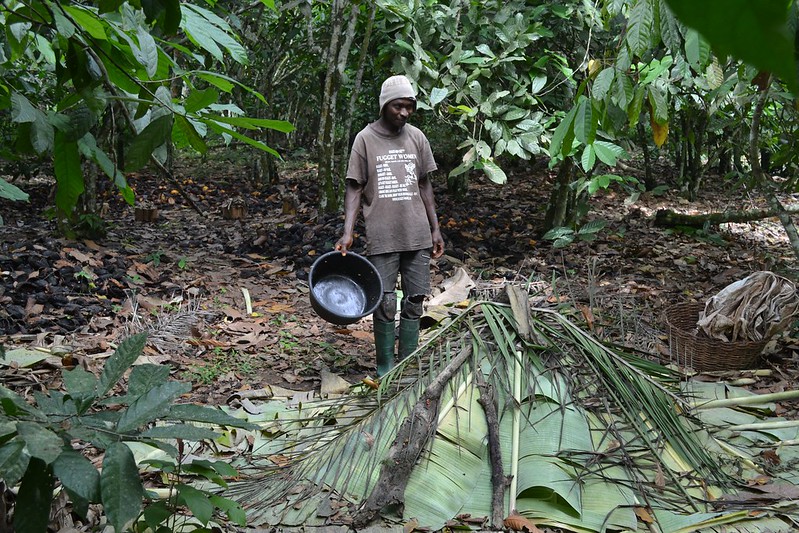Read in
While known for its forestry and animal life, cocoa is a major part of Ghana’s economy. With a multidimensional poverty rate of 24.6%, around 850,000 farms in the region participate in harvesting and producing cocoa. The crop brings about $2 billion in foreign exchange and has become a staple in many items like chocolate. Unfortunately, cocoa disease in Ghana is infecting rural areas and is shifting inflation and production values. Inconsistent rates are affecting the primary source of income for farmers, raising concerns about a potential increase in rural poverty.
Cocoa Stats and Disease Updates
Cocoa Swollen Shoot Disease (CSSVD) was first detected in the east of Ghana in 1936 and has remained a problem while spreading to the west. The disease has affected the Ghanaian region for years and has circulated in countries like Togo and Nigeria. The disease is passed through insects, known as mealybugs, and harms the development of cocoa trees within two to three years of infection, indefinitely killing the development of healthy cocoa.
According to the African Development Bank (AfDB) 2018 annual report, the bank supported private sector projects like helping the Ghana Cocoa Board (COCOBOD). CSSVD has remained an issue in rural areas, where the cocoa industry employs around 800,000 families, as the board introduced loans and rehabilitation in 2018. Investing around $600 million in Ghana’s Cocoa Board intended to transform the value chain of cocoa.
In 2018/ 2019, the drop in production fell to 811,250 tonnes due to CSSVD. With the help of AfDB, COCOBOD launched Productivity Enhancement Programmes to help fight the disease outburst and control production. In 2023, COCOBOD announced that PEPs would continue to address production drop.
Despite ongoing efforts to defeat cocoa disease in Ghana, it remains a crucial problem for Ghanaian farmers. A 2024 report from the International Cocoa Organization (ICCO) revealed that around 81% of Ghana’s cocoa-producing area has become affected. The region covers about 410,229 hectares, with 330,456 hectares infected.
Economic Impact
Higher chocolate prices have caused inflation to rise, challenging Ghana’s economy. Not only is this spike harmful, but the rise of illegal mining and smuggling plays a crucial role in a lower economy.
Illegal mining, known as galamsey, has been an ongoing issue in Ghana and continues to affect the cocoa industry. According to COCOBOD, in April 2022, illegal mining had caused significant problems for cocoa farms, as Peter Mac Manu (chairman of COCOBOD) urged action to maintain the problem. COCOBOD and the Minerals Commission discussed the need to collaborate to find solutions. To address this, the Minerals Commission had started a Community Mining Scheme to control mining activities. As of 2023 and 2024, galamsey is still an ongoing issue. COCOBOD is working on new laws to protect rural farmers and their livelihoods.
Cocoa prices have fluctuated in Ghana as product production has caused prices to rise and fall. A 2024 ICCO report showed that the market had tight supplies and shifting prices due to the delay of delivery by Ghana and their poor crop production. Because of the shortage of cocoa, the price rose.
Disease Management
Though CSSVD is not curable, the Ghana government is working to advance agriculture and strengthen the economy. According to the World Bank, in 2023, the Ghanaian Government received $200 million from the World Bank’s International Development Association (IDA). The money has been allocated to support the Ghana Tree Crop Diversification Project. The goal is to modernize farming and increase the production of crops like cocoa. To ensure the project runs efficiently, the Ghana Cocoa Board and the Tree Crops Development Authority will oversee the work.
In COCOBOD’s recent press announcement from July 2024, the board announced it had secured $100 million from the World Bank to help control cocoa and rehabilitate older farms –using the “cutting-out approach” to remove infected dead trees. The cutting-out approach is a common disease management tactic used over the years to minimize disease spreading to newly planted trees.
Closing Remarks
Due to price fluctuations and ongoing tree death rates, cocoa disease in Ghana remains a constant problem, affecting income rates for farmers. There is, however, hope for better crop production thanks to rehabilitation and ongoing efforts advocating for better farming methods.
– Savannah Garza



